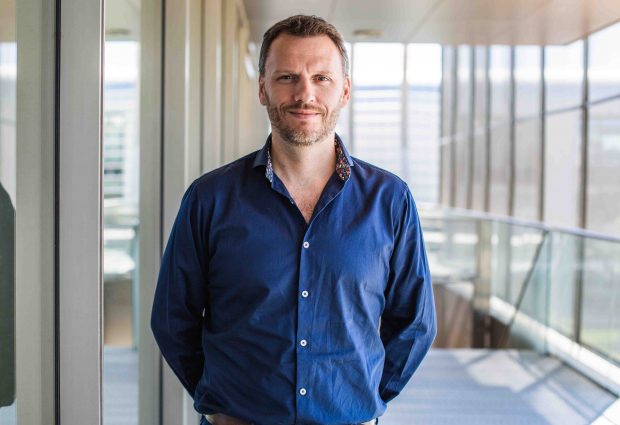
Read the latest Issue
EMBL-EBI Group Leader Rob Finn shares high insights on public engagement

Rob Finn leads EMBL-EBI’s Sequence Families team, which is responsible for the InterPro, Pfam, Rfam and RNAcentral data resources. The team also looks after EMBL-EBI’s fast-growing metagenomics data service, MGnify. Rob also leads a research group that focuses on developing computational approaches for the reconstruction of genomes from metagenomes. The group also investigates the distribution of microbes and functions in different environments and probes the functions of so-called ‘microbial dark matter’.
The gut microbiome consists of all the microorganisms that live inside your gut. These are the microscopic cells and other entities that you can’t see with the naked eye. It’s estimated that there are up to a hundred trillion microbes living on or in your body. We estimate that there are about 1000 different species that encode over 50 million genes. A human genome only encodes about 22 000 genes, so it shows you that microbes have got a lot of functional capacity.
Our aspiration is to take metagenomic data and infer new knowledge that we can share with the rest of the scientific community. There are currently 13 500 datasets that we’ve analysed for the gut microbiome. We wanted to see whether we could reconstruct genomes for those 13 500, and then look at the patterns and the diversity of the genomes. One of the main reasons for focusing on this area is that the gut microbiome provides us with lots of data.
The traditional way of studying microbiota is to streak out a sample on plates, pick colonies and then grow those bacteria so you have enough DNA for sequencing. The other approach is metagenomics, which allows you to analyse all the DNA and try to get genomes from that.
The first approach is fundamentally slow because you have to work out the right growing conditions. A lot of these members of the gut microbiota are quite fastidious about how they grow and what they consume. Metagenomics takes away that need to grow the organisms, but generates another problem: you end up with fragments of genomes from many different species in a sample. You have to computationally piece all the bits of genome back together again – the so-called jigsaw puzzle analogy.
In the last two or three years there’s been an increase in the quality of the algorithms we use to analyse metagenomics data and piece together these genomes at scale. In bioinformatics, we’re not only piecing together but we’re also annotating the genomes and looking for patterns. For example, is there a functional distinction between the things that we’ve seen previously and what we’re recovering now, and can we try to estimate the quality of what we’ve recovered?

We’re beginning to establish mechanistic models – an understanding of the factors affecting the development of an illness or disease within a patient – for chronic illnesses like C. difficile bacterial infection or Crohn’s disease. We know from both mouse and human trials that, in the case of C. diffcile, the faecal microbiome transplant (FMT) is the best ‘medicinal’ approach. I use the term ‘medicinal’ very loosely because there is about a 30% recovery rate if we match the right donor with the right recipient. There are lots of risks associated with the FMT, because we don’t know exactly what we’re transferring. This has sometimes led to acquired antimicrobial resistance, which is a problem. The aspiration is to define those key members of the microbial community that could be given in a pill – a less intrusive and more effective treatment.
Another exciting topic, maybe for the longer term, is how we could manipulate bacteriophages – viruses that infect bacteria – to change the gut microbiome. I think phage manipulation could bring about a new wave of antimicrobials.
I talk to my kids and there are some things that they go “wow!” about, while to other things they say, “Dad, you’re boring”. I would really like to get some of that “wow!” into a presentation and inspire others. It’s also about trying to increase the awareness of microbiome research: why we do it, some of the caveats and what the future could bring.
I think it’s really important on the one hand to inspire emerging scientists, irrespective of age, but also to give a clear take-home message about what science is doing now: the potential but also the caveats. I had a lot of questions after my talk about different applications of microbiome research. Sometimes I had to say, “I don’t know.” Or “we do not have enough data to support that.” I think that shows you that there is a curiosity from the public, and they ask questions that maybe I hadn’t thought about.
It’s very much about getting the message of science out there such that people understand it and aren’t scared of it.
I felt a strong mixture of excitement and apprehension. The apprehension came from thinking “what happens if no one turns up?” or “what happens if people start walking out due to boredom?”. The excitement was to reach out to people I don’t normally speak to about my work.
In preparation I worked to focus the talk on two fundamental basic questions that are accessible to everyone: “what is the gut microbiome and its role?” and “how is bioinformatics giving us new information?”. I think this actually helps when giving scientific talks as well, because you really home in on your key message. It was nice to get a different point of view on presentations, slides and illustrations. It was all very positive and I would thoroughly recommend it to others.
The event was made possible with the support of the Connecting Science Public Engagement Team on the Wellcome Genome Campus in Hinxton, UK.
Looking for past print editions of EMBLetc.? Browse our archive, going back 20 years.
EMBLetc. archive